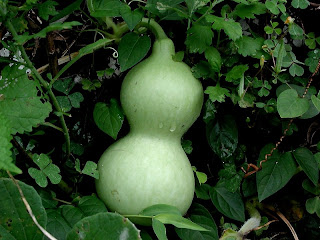Lagenaria siceraria (synonym Lagenaria vulgaris Ser.), bottle gourd, opo squash or long melon is a vine grown for its fruit, which can either be harvested young and used as a vegetable, or harvested mature, dried, and used as a bottle, utensil, or pipe. For this reason, the calabash is widely known as the bottle gourd. The fresh fruit has a light green smooth skin and a white flesh. Rounder varieties are called calabash gourds. They come in a variety of shapes, they can be huge and rounded, or small and bottle shaped, or slim and more than a meter long.
The calabash was one of the first cultivated plants in the world, grown not primarily for food, but for use as a water container. The bottle gourd may have been carried from Africa to Asia, Europe and the Americas in the course of human migration. It shares its common name with that of the calabash tree (Crescentia cujete).
Etymology
The word comes from the Spanish calabaza, possibly from Arabic qar'a yabisa "dry gourd", from Persian kharabuz, used of various large melons; or from a pre-Roman Iberian calapaccia

No comments:
Post a Comment